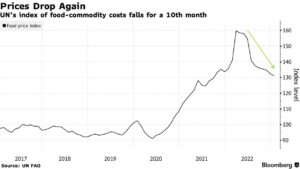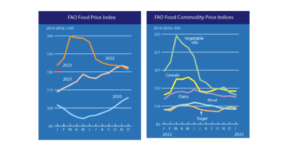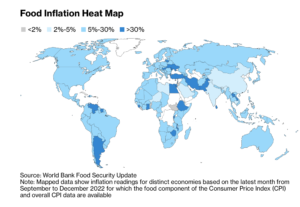Agriculture Secretary Brooke Rollins said on Tuesday that the Trump administration will announce a 'bridge payment' for farmers next week that is designed to provide short-term relief while longer trade…
For 10th Consecutive Month, World Food Prices Fall
Reuters writer Crispian Balmer reported today that, “World food prices fell in January for a 10th consecutive month, and are now down some 18% from a record high hit last March following Russia’s invasion of Ukraine, the United Nations food agency said on Friday.

“The Food and Agriculture Organization’s (FAO) price index, which tracks the most globally traded food commodities, averaged 131.2 points last month against 132.2 for December.
It was the lowest reading since September 2021.
“The December figure was revised down from an original estimate of 132.4.”

The Reuters article noted that, “Falls in the prices of vegetable oils, dairy and sugar helped pull down the index, while cereals and meat remained largely stable, the FAO said.
“In separate cereal supply and demand estimates on Friday, the FAO raised its forecast for global cereal production in 2022 to 2.765 billion tonnes from a previous estimate of 2.756 billion tonnes.”
Also today, Dow Jones writer Yusuf Khan reported that, “The U.N. body said that much of the easing had been led by lower wheat prices but that grain prices overall were more or less unchanged from December with a FAO cereal price index reading of 147.4 points in January, a rise of just 0.1%. Wheat prices had fallen 2.5% during the month on higher Russian and Australian wheat exports, but strong demand for corn had meant flat grain prices overall.”
And Bloomberg writer Agnieszka de Sousa reported today that, “As a rout in the price of food commodities from wheat to cooking oil deepens, the cost of products on grocery shelves continues to rise.”

The Bloomberg article explained that, “Food executives are warning of more price hikes to come, even as commodities like palm oil and dairy decline. Diplomats talk of the worst food crisis since World War II, with parts of Africa on the brink of famine.
This striking dissonance underscores the significant time lag for farmgate prices to feed through to those paid by households. Moreover, food commodities only make up a small proportion of the cost inputs for products such as breakfast cereals.
Today’s article added that, “In the US, the farm level portion of food consumed at home is about quarter of the costs, and only about 5% when eating out, according to Joseph Glauber, former chief economist at the US Department of Agriculture.
“Take bread. The cost of wheat accounts for as much as a 10th of the total cost of a loaf, Glauber said. The rest is driven by transporting the wheat, milling it, making and baking the bread, packaging it and stocking grocery stores, he said.
“Higher energy prices are still feeding through to processing costs, workers are demanding higher wages and suppliers are pushing retailers for higher pay.”





